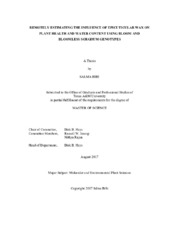| dc.description.abstract | Sorghum (Sorghum bicolor L. Moench) is an important crop grown for both fodder
and food, especially in Africa and Asia. Although it can cope with water shortage, long-term stress affects sorghum growth and productivity. The presence of epicuticular wax
(EW) on the vegetative body of sorghum is one effective mechanism for conferring
drought resistance. The heavy wax covering is termed “bloom,” while bloomless types
lack EW layer. The presence of EW has been associated with low abiotic stress
tolerance, as each phenotype is associated with the wax composition and not the wax
content. However, to monitor the influence of this drought-adaptive trait on plant
growth, health and water use efficiency is limited by the unavailability of suitable
phenotyping methods. The high resolution hyperspectral imagery consists of more than
200 narrow spectral bands that can monitor plant responses to drought over critical
phenological stages throughout the plant life cycle. This study focused on determining
the influence of epicuticular wax on plant health and water use efficiency (WUE) using
recombinant inbred line population derived by Stg4*M1789. Physiological data was
collected from field trails in CS and a greenhouse experiment. The EW data and
hyperspectral data was collected at different phenological growth stages at the same
time. Our results confirmed that under well-watered conditions the high EW lines had
higher WUE compared to low wax lines, but the low wax lines had adapted a short-term
resistance to water loss under water deficit conditions. Differences were observed in the reflectance pattern between the lines across the photosynthetic active (400-700nm) region and the near infrared (700-1200nm) region. The lines with consistently high and low wax were measured for their carotenoids content, plant greenness, water content and photochemical reflectance with a marked difference being found in their pattern.
The reflectance index tends to increase in case of carotenoids pigments for low
wax lines as the age of plants increase and senescence. Water band and green normalized vegetation index does not seem to be affected much by the presence of epiculticular wax and is considered a more robust estimation of the water and biochemical content. The plant senescence reflectance index increased with a decrease of epicuticular wax during the vegetative stage of plant development and continued into extended plant maturation compared to high wax genotypes indicated canopy stress for low wax lines. The Spectral-Indices related vegetation increases with an increase in EW, which indicates the overall plant health and growth for RILs with higher leaf wax content. | en |


